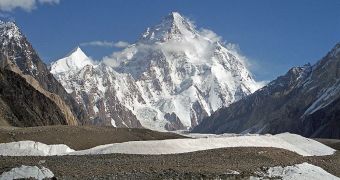According to the conclusions of a new scientific study, it would appear that a significant portion of the ices covering the Himalaya mountain chain is stable and even growing at some places. This is due to an insulating layer of debris that allows it to remain isolated from the warming world.
These findings are in direct contradiction with some of the conclusions published in the 2007 Intergovernmental Panel on Climate Change (IPCC) report. The document said the Himalayas could lose all their ices by 2035.
The new study shows that this will most likely not be the case. Some 58 percent of the glaciers in the Karakoram mountains are holding steady, or growing up to 12 meters per year. These mountains hold about half of the ices in all the Himalaya range.
However, the experts behind the investigation remind that 65 percent of glaciers located throughout the entire mountain range are shrinking. Therefore, the new discovery should not be interpreted as saying that ice covers in the Himalayas are not under stress.
Details of the new research effort were published in the January 23 issue of the esteemed scientific journal Nature Geoscience. The work was authored by German investigator Dirk Scherler, from the University of Potsdam, and colleagues.
The researchers analyzed 286 high-resolution, satellite images of Himalayan glaciers thoroughly. All the views had been collected between 2000 and 2008. The ices were found to be receding everywhere except the Karakoram mountains.
It was additionally discovered that glaciers outside this special region tended not to flow (be stagnant), which is always a sign of poor health, the investigations team explains, quoted by Science News.
Wilfrid Laurier University expert Kenneth Hewitt said in a 2005 paper that glaciers on the Karakoram mountains were dwindling too a couple of decades ago, and that they resumed growing in the late 1990s.
A rocky blanket of debris is the main reason why the glaciers remained stable on those mountains, or continued growing. When the depth of the sediments exceeds several centimeters, they produce a thermal blanket that prevents higher temperatures from melting the ice below.
The research team found that the rocky debris covering the glaciers on the Karakoram mountains include house-sized boulders. This is a perfect explanation of why the glaciers remained stable.

 14 DAY TRIAL //
14 DAY TRIAL //